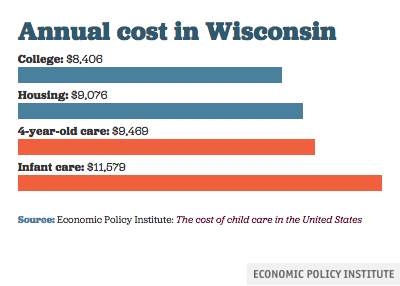Early Care & Education
Access & AffordabilityParents and caregivers of Wisconsin’s youngest children continue to struggle to afford, access and maintain child care. Far too frequently, the high cost and inability to find child care puts parents and caregivers in an all-too difficult position: Choose between work or having a family. Or, in some cases, leave a job or decide not to take a new position because of child care challenges.
CHILD CARE COSTS ARE OUT OF REACH
for many because it is considered unaffordable if it costs more than 7% of a family’s income. By this standard, nearly 94% of Wisconsin families cannot afford child care for an infant. A single minimum-wage worker in Wisconsin would need to work full-time for 43 weeks of the year just to pay for infant child care, which averages about $1,047 a month. A family with the state’s median income would use 18.5% of their annual income for child care for one infant. A typical family with two children – an infant and a 4-year-old – would need to spend more than one-third of their annual income to afford child care.
CHILD CARE IS A SECTOR comprised
of thousands of regulated, independent small businesses funded predominantly by parent fees. Rates are set by what parents are willing and able to pay – not what it actually costs to run a high-quality program. A majority of a child care center’s budget goes toward paying its highly educated and experienced child care professionals, who, despite their education and tenure, are significantly undercompensated. Budgets also include costs for facilities and operations, food and other necessities. Accordingly, programs operate on razor-thin margins.
WAITLISTS FOR CHILD CARE PROGRAMS
continue to grow, some as far into the future as two or three years. This is true for much of Wisconsin, including 70% in rural areas, which are considered a “child care desert.” This means there is only one licensed child care slot for three or more children under age 5. In short, there are far more children and families who need child care than there is care available.
IN HER WORDS
“If you want your local economy to thrive, you need to take care of your working parents. There are unfilled jobs in this community all over the place because we live in a child care desert. There’s only enough care for one in three kids in this area, which means parents are not able to work. It’s not just the problem of the parent – it’s the community’s issue.”
-AMBER, GREEN BAY
Dig In Further
Affordability Calculator
Select your county and see how much money is left over for child care after paying for basic expenses.
Economic Disparities
The cost of child care, among other economic factors, influence Wisconsin families’ health outcomes.

